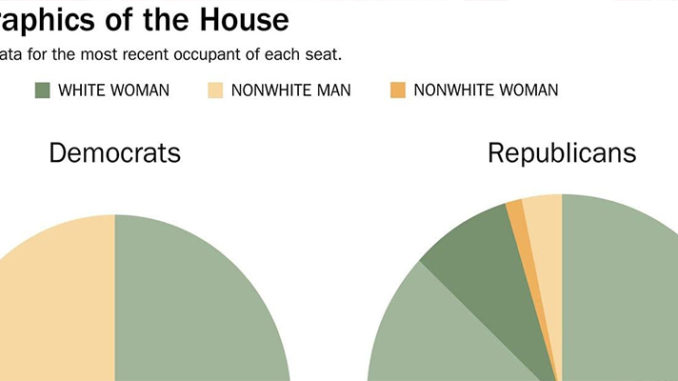
by Philip Bump, Washington Post
Few tweets better encapsulate politics in the United States at the moment than this one from the Cook Political Report’s Dave Wasserman.
We’ve noted before that there are two tracks that have defined the election cycle to date — the strength of female candidates among Democrats and the success of Republican candidates who have embraced President Trump. Wasserman, though, captures something a bit broader. The Democratic Party and the Republican Party are headed in different directions more broadly than that.
It’s already the case, as Wasserman’s tweet suggests, that the composition of the two parties’ House delegations look very different from each other.
Including data for the most recent seat-holders in districts that are currently not represented by anyone, Wasserman’s point is clear. The vast majority of Republican representatives are white men. Most Democratic representatives aren’t.
That is certainly in part because the Democratic Party, unlike the Republican Party, is quickly becoming more diverse. Data from the Pew Research Center released in March shows that the density of whites in the Democratic Party has fallen from 75 percent to 59 percent over the past 20 years. The density of whites in the Republican Party declined from 92 percent to 83 percent — meaning that the Republican Party now is substantially more heavily white than the Democratic Party was during the Clinton administration.
Wasserman’s tweet was a response to the victory of Ayanna Pressley in the Democratic primary for Massachusetts’s 7th Congressional District. Pressley handily defeated Rep. Michael E. Capuano, who has represented the area since 2013. She is a Boston City Council member whose deep roots in the district helped her prevail. She’s also a black woman, while Capuano is a white man. It’s clear that this, too, helped her bid.
So far, there have been four sitting members of the House who have lost primary challenges. They are:
- Rep. Robert Pittenger (R-N.C.)
- Rep. Mark Sanford (R-S.C.)
- Rep. Joseph Crowley (D-N.Y.)
- and Capuano
Sanford, Crowley and Capuano all lost to women. Crowley and Capuano lost to women of color.
That’s significant because, as Wasserman hints, the victors in those latter two races — Alexandria Ocasio-Cortez and Pressley — are more representative of their districts demographically than the Democrats they beat. (Pressley faces no Republican opponent in November; Ocasio-Cortez is expected to win easily.)
About three-quarters of the districts in the House are majority white, according to Census Bureau data. (In this article, we’ll use “white” to refer to non-Hispanic whites and “black” to refer to non-Hispanic blacks.) The vast majority of those majority-white districts are represented by white Republicans (214 of 312). Most of the majority nonwhite districts are represented by nonwhite Democrats (73 of 123).
(The racial and ethnic distributions above use data from the House itself. You can see historical data on black, Hispanic and Asian members of Congress online. Rep. Bobby Scott (D-Va.) is both black and Asian.)
You can see from that chart that Crowley and Capuano represented majority nonwhite districts. Pittenger and Sanford, who lost to white opponents, represented mostly white districts.
What’s more, the district won by Pressley was one of the seven most heavily black districts still represented by a white Democrat. (The most heavily black district represented by a white Democrat is that of Rep. Steve Cohen, in Tennessee, which is two-thirds black.)
Ocasio-Cortez, meanwhile, won a district that is about half Hispanic. It was the fifth-most-heavily Hispanic district still represented by a white Democrat.
The most heavily Hispanic district represented by a white Democrat is that of Rep. Beto O’Rourke (D-Tex.) — at least until January. O’Rourke is giving up his seat to run for Senate. Veronica Escobar, a Hispanic woman, won the Democratic primary to replace him.
Of course, most districts see another disparity in representation. Most House districts are home to more women than men, but most members of Congress are men. Of the four districts where incumbents lost in the primaries, only Crowley’s is a majority male.
Interestingly, if not surprisingly, the most heavily female districts are represented by Democrats. The most heavily male districts are represented by Republicans, including the seats held by Reps. David Valadao (R-Calif.) and Don Young (R-Alaska), the most heavily male in the country.
Young is an outlier in his own right. Most members of Congress also differ from their constituencies in the sense that they’re much older. Only 16 House districts are represented by members of the House who are younger than the median age in the district. Coming into the 115th Congress, Young was the fifth-oldest member of the House. But a spate of announced retirements, the resignation of Rep. John Conyers Jr. (D-Mich.) and the death of Rep. Louise M. Slaughter (D-N.Y.) (those outlined in the black box below) means Young will be the oldest serving member of the House come January.
The representative serving the oldest constituency is Rep. Daniel Webster (R-Fla.). Rep. Conor Lamb (D-Pa.), who won a special election this year, is the member of Congress who’s youngest relative to his constituency.
That won’t change in January, but he’ll have competition. Crowley was about two decades older than the median resident of his New York district; Ocasio-Cortez will be the youngest member of Congress and is more than eight years younger than the median resident. (Lamb is about 10 years younger than the median in his district.) Pressley, too, is substantially younger than the man she’ll replace on Capitol Hill, though she’s older than the median. Sanford and Pittenger also lost to opponents more than a decade younger than them.
These shifts in the Democratic primaries are not yet the norm. There are still a lot of established members of the House who are easily holding their positions despite not necessarily reflecting the communities they serve in demographic terms. But the Capuano and Crowley losses increasingly look as if they’ll help define this era in American politics: The Democratic House caucus in particular is shifting to look more like the Democratic Party itself.
Philip Bump is a politcal analyst for The Washington Post. Follow Philip










